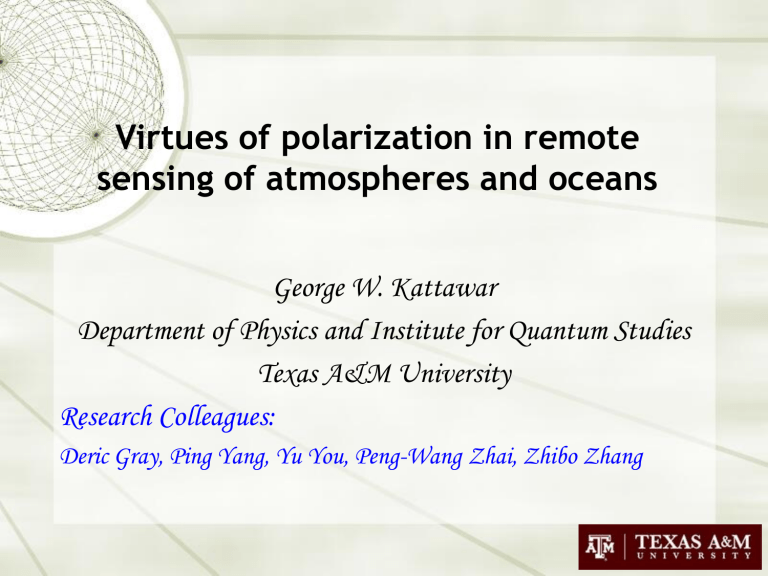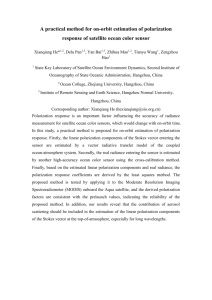AGU-07-Kattawar

Virtues of polarization in remote sensing of atmospheres and oceans
George W. Kattawar
Department of Physics and Institute for Quantum Studies
Texas A&M University
Research Colleagues:
Deric Gray, Ping Yang, Yu You, Peng-Wang Zhai, Zhibo Zhang
Scattering Geometry
Scattering object i
Incident beam E
E i
Scattering plane
E s
Scattering amplitude matrix
E s
Scattering angle
E s
E s
e ikr
ikr
S
2
S
4
S
3
S
1
E i
E i
Stokes vector-Mueller matrix formulation
The electric field can be resolved into components. E l and E r are complex oscillatory functions.
E = E l l + E r r
The four component Stokes vector can now be defined.
They are all real numbers and satisfy the relation
I 2 = Q 2 + U 2 + V 2
I
E l
E l
Q
E l
E l
E
E r r
E
r
E
r
U
E l
E
r
V
i ( E l
E
r
E r
E l
E r
E l
)
I
I l l
I r
I r
The Mueller matrix relates the incident and scattered Stokes vectors
V s
I
Q s s
U s
M
M
21
M
11
31
M
41
M
12
M
22
M
32
M
42
M
13
M
23
M
33
M
43
M
M
14
24
M
34
M
44
Ii
Q
U i i
V i
Stokes vector and polarization parameters
I is the radiance (this is what the human eye sees)
Q is the amount of radiation that is polarized in the 0/90 0 orientation
U is the amount of radiation polarized in the +/-45 0 orientation
V is the amount of radiation that is right or left circularly polarized
DOP= Degree of polarization=
Q
2
U
2
V
2
/ I
DOLP = Degree of linear polarization =
Q
2
DOCP = Degree of circular polarization = |V|/I
U
2
Orientation of plane of polarization = tan -1 (U/Q)
/ I
Ellipticity= Ratio of semiminor to semimajor axis of polarization ellipse=b/a
=tan[(sin -1 (V/I))/2]
Polarizer and analyzer settings for Mueller matrix measurements
Diagram showing the input polarization
(first symbol) and output analyzer orientation (second symbol) to determine each element of the SSMM denoted by S ij
For example, HV denotes horizontal input
. polarized light and a vertical polarization analyzer. The corresponding symbols denoting polarization are V, vertical; H, horizontal; P, +45 , M, -45 ; R, right handed circular polarization; L, left handed circular polarization; and O, open or no polarization optics. This set of measurements was first deduced by Bickel and Bailey.
S
11
(OO)
S
12
S
13
S
14
(HO-VO) (PO-MO) (LO-RO)
S
21
S
22
(OH-OV) (HH-VV) -
(HV+VH)
S
23
(PH-MV) -
(PV+MH)
S
24
(LH-RV) -
(LV+RH)
S
31
S
32
S
33
(OP-OM) (HP-VM) - (PP-MM) -
(HM+VP) (PM+MP)
S
34
(LP-RM) -
(LM+RP)
S
41
(OL-OR)
S
42
(HL-VR) -
(HR+VL)
S
43
(PL-MR) -
(PR+ML)
S
44
(LL-RR) -
(RL+LR)
Plankton as viewed by a squid
Planktonic animal as seen through "regular" vision
As seen when placed between two crossed linear polarizing filters
As seen by putting the two polarizers at 45 ° to each other
Contrast enhancement using polarization
Photo taken with a flash lamp and no polarization optics
Photo taken with circular polarized light for illumination and a circular analyzer for viewing
I
Nissan car viewed in mid-wave infrared
Q U
V
This data was collected using an Amber MWIR InSb imaging array 256x256.
The polarization optics consisted of a rotating quarter wave plate and a linear polarizer. Images were taken at eight different positions of the quarter wave plate
(22.5 degree increments) over 180 degrees. The data was reduced to the full
Stokes vector using a Fourier transform data reduction technique.
Bacillus anthracis
QuickTime™ and a
TIFF (Uncompressed) decompressor are needed to see this picture.
Experimental Setup
Yong-Le Pan, Kevin B. Aptowicz, Richard K. Chang, Matt Hart, and Jay D. Eversole,
Characterizing and monitoring respiratory aerosols by light scattering, Optics Letters ,
Vol. 28, No. 8, p589 (2003).
x source y
Coordinate Setup
detector y x
Z ’ z
Laser beam
ˆ ˆ ˆ z
The symmetry axis is in the yz plane.
Mueller Image Generating Method
We plot the reduced mueller matrix elements on a circular plane shown as in the figure below.
Reduced mueller matrix means all mueller elements except M11 are normalized to M11, which are in the range from -1 to +1.
For the M11 element, we use the phase matrix P11 value.
y
90
M(
,
)
In our mueller image generation, radial position has linear relation to the scattering polar angle. The actual experimental detection may not have same relation. The resultant images will be different than the images shown here.
-90 r
90 x r
180
-90
,
90,180
Outer coat
=0.5
m
Particle Model-1: Spore
1.0
m
Inner coat
Cortex
0.8
m
Core
Philip J. Wyatt, “Differential Light Scattering: a Physical
Method for Identifying Living Bacterial Cells”, Applied
Optics, Vol.7,No. 10,1879 (1968)
Simulation Models
m=1.34
0.8μm
(a)
1.0μm
(b) m=1.34
1.0 or 2.0
μm
0.5 μm
(c) (d)
Homogenous Spore Mueller Image
= 0 o
=0.5
m m=1.34
1.0
m
0.8 m
Spore with Core Mueller Image
= 0 o
=0.5
m
Core 1.0
m
0.8
m
Homogenous Cylinder Mueller Image height=1
m,
=0 o m=1.35
1.0
m
0.5
m
= 0.532
m
m=1.35
Homogenous Cylinder Mueller Image height = 2
m,
= 0 o
2.0
m
0.5
m
= 0.532
m
Mueller Image for Three Particles
=90 o
=0.5
m
P
11
P
33
P
34
P
44 m=1.34
1.0
m
0.8 m
1.0
m
0.8 m
1.0
m
0.5
m m=1.35
= 0.532
m
Properties of the Target
2. Depolarizing
1 0 0 0
0 0 0 0
0 0 0 0
0 0 0 0
R = 0.10 m.f.p.s
R = 0.067
The target reflects light with a Lambertian distribution. The albedo is constant across surface, but each annular region has a different reduced Mueller matrix .
R = 0.033
1. Polarization
Preserving
1 0 0 0
0 1 0 0
0
0
0
0
1
0
0
1
3. Painted Surface
1 0
0 0.61
0
0 0
0 0
0
0
0
0
0.58
0
0.51
Geometry of the Imaging System
Incident Beam
Detector
Detector resolution
Detector field of view
Target Depth
Medium
Target
Properties of the Model
The attenuation coefficient is fixed , but the absorption and scattering coefficients can be varied. All distances are given in units of photon mean free path (m.f.p.)
The system is assumed to be an active source , so there is full control over all aspects of both source and detector.
The detector details are intentionally left out; only the radiometric quantities at the detector location are calculated.
The problem is solved for a time-independent case.
Inherent Optical Properties of the
Medium
Two classes of phase functions are used to describe the scattering by the medium:
Henyey-Greenstein (HG):
HG
g
4
1
1
g 2
1 2 g
g 2
3
2
g
cos
Two-Term Henyey-Greenstein (TTH):
TTH g g
1 2
)
HG g
1
HG
g
2
)
0
1
The single-scatter reduced Mueller matrix for ocean water is taken to be that of Rayleigh scattering :
1 b
0 0 b
1 0 0
0 0 d
0
0 0 0 d
b
cos cos
2
2
1
1
2cos cos 2
1
Results
The target depth is kept constant at 2 m.f.p.s
The target albedo is kept constant with a value of 0.025
The effective Mueller matrix elements of the system are calculated for different phase functions and single scatter albedos of the medium.
Due to the form of the matrix elements of the target and the backscattering geometry of the imaging system, only the diagonal elements of the effective Mueller matrix are non-zero.
Mueller Matrix Elements
HG g=0.95 phase function Medium Albedo = 0.25
m
11 m
22 m
33 m
44
HG g=0.5
v = 0.5
v = 0.25
Radiance
HG g=0.8
v = 0.5
v = 0.25
v
HG g=0.95
= 0.5
v = 0.25
TTH SBP v = 0.5
v = 0.25
TTH LBP v = 0.5
v = 0.25
HG g=0.5
v = 0.5
v = 0.25
%
22
HG g=0.8
v = 0.5
v = 0.25
v
HG g=0.95
= 0.5
v = 0.25
TTH SBP v = 0.5
v = 0.25
TTH LBP v = 0.5
v = 0.25
HG g=0.5
v = 0.5
v = 0.25
%
33
HG g=0.8
v = 0.5
v = 0.25
v
HG g=0.95
= 0.5
v = 0.25
TTH SBP v = 0.5
v = 0.25
TTH LBP v = 0.5
v = 0.25
HG g=0.5
v = 0.5
v = 0.25
%
44
HG g=0.8
v = 0.5
v = 0.25
v
HG g=0.95
= 0.5
v = 0.25
TTH SBP v = 0.5
v = 0.25
TTH LBP v = 0.5
v = 0.25
0.004
Mueller Matrix Elements
Medium Albedo = 0.25
Radiance M
1.0
0.003
0.8
0.002
0.6
0.001
0.4
0.000
0.0
0.1
0.2
0.3
0.4
0.2
0.0
M
0.2
0.0
-0.2
-0.4
-0.6
0.2
0.0
-0.2
-0.4
-0.6
-0.8
-0.8
-1.0
0.0
0.1
0.2
0.3
0.4
Radial Distance from Target Center (m.f.p.)
-1.0
0.0
0.1
0.1
0.2
M
0.2
0.3
HG g=0.95
HG g=0.8
HG g=0.5
TTH LBP
TTH SBP
0.3
0.4
0.4
0.008
Mueller Matrix Elements
Medium Albedo = 0.5
Radiance
M
1.0
0.8
0.006
0.6
0.004
0.002
0.000
0.0
0.1
0.2
0.3
0.4
0.4
0.2
0.0
M
0.2
0.0
-0.2
-0.4
-0.6
0.2
0.0
-0.2
-0.4
-0.6
-0.8
-0.8
-1.0
0.0
0.1
0.2
0.3
0.4
Radial Distance from Target Center (m.f.p.)
-1.0
0.0
0.1
0.1
M
0.2
0.2
0.3
HG g=0.95
HG g=0.8
HG g=0.5
TTH LBP
TTH SBP
0.3
0.4
0.4
Conclusions
•
Only correct way to do radiative transfer calculations
•
Mueller matrix contains all the elastic scattering information one can obtain from either a single particle or an ensemble of particles
• Provides a unique “fingerprint” of particle morphology, orientation, and optical properties
•
Can provide information about surface features of objects which can’t be obtained with ordinary radiance measurements
•
Can even be used for the detection of precancerous skin lesions





